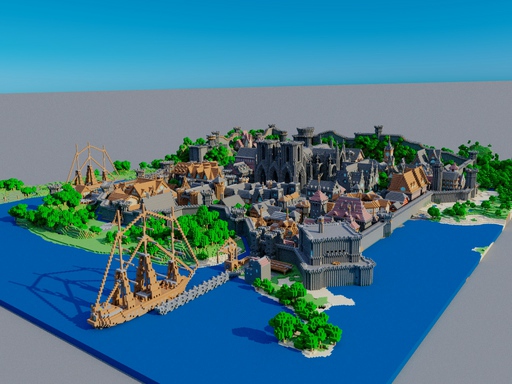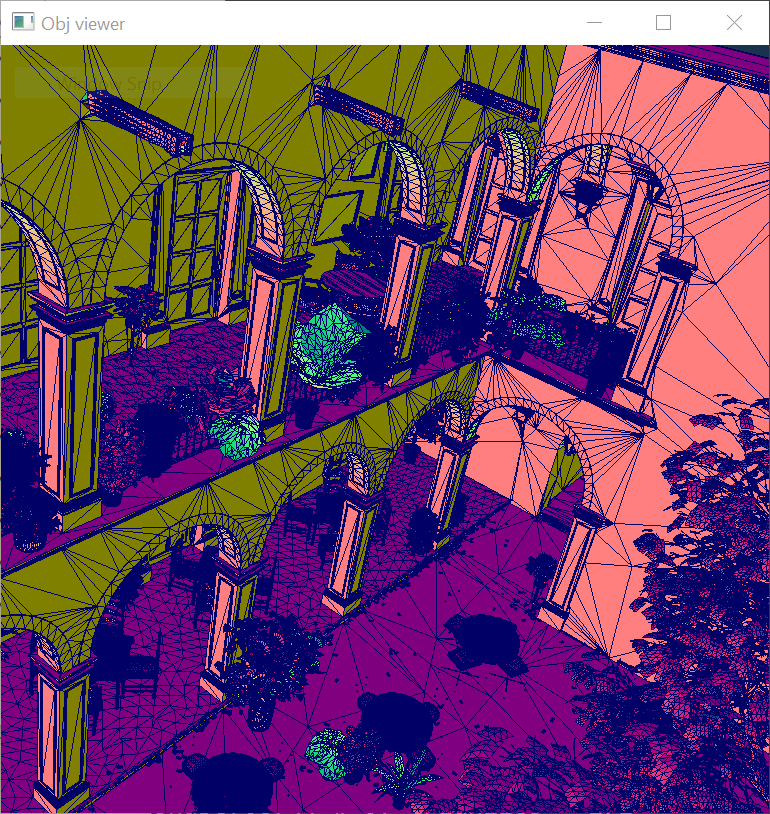Tiny but powerful single file wavefront obj loader written in C++03. No dependency except for C++ STL. It can parse over 10M polygons with moderate memory and time.
tinyobjloader is good for embedding .obj loader to your (global illumination) renderer ;-)
If you are looking for C89 version, please see https://github.com/syoyo/tinyobjloader-c .
We recommend to use master(main) branch. Its v2.0 release candidate. Most features are now nearly robust and stable(Remaining task for release v2.0 is polishing C++ and Python API).
We have released new version v1.0.0 on 20 Aug, 2016.
Old version is available as v0.9.x branch https://github.com/syoyo/tinyobjloader/tree/v0.9.x
- 29 Jul, 2021 : Added Mapbox's earcut for robust triangulation. Also fixes triangulation bug.
- 19 Feb, 2020 : The repository has been moved to https://github.com/tinyobjloader/tinyobjloader !
- 18 May, 2019 : Python binding!(See
pythonfolder. Also see https://pypi.org/project/tinyobjloader/) - 14 Apr, 2019 : Bump version v2.0.0 rc0. New C++ API and python bindings!(1.x API still exists for backward compatibility)
- 20 Aug, 2016 : Bump version v1.0.0. New data structure and API!
- C++03 compiler
Previous old version is available in v0.9.x branch.
tinyobjloader can successfully load 6M triangles Rungholt scene. http://casual-effects.com/data/index.html
- examples/viewer/ OpenGL .obj viewer
- examples/callback_api/ Callback API example
- examples/voxelize/ Voxelizer example
TinyObjLoader is successfully used in ...
- Double precision support through
TINYOBJLOADER_USE_DOUBLEthanks to noma - Loading models in Vulkan Tutorial https://vulkan-tutorial.com/Loading_models
- .obj viewer with Metal https://github.com/middlefeng/NuoModelViewer/tree/master
- Vulkan Cookbook https://github.com/PacktPublishing/Vulkan-Cookbook
- cudabox: CUDA Solid Voxelizer Engine https://github.com/gaspardzoss/cudavox
- Drake: A planning, control, and analysis toolbox for nonlinear dynamical systems https://github.com/RobotLocomotion/drake
- VFPR - a Vulkan Forward Plus Renderer : https://github.com/WindyDarian/Vulkan-Forward-Plus-Renderer
- glslViewer: https://github.com/patriciogonzalezvivo/glslViewer
- Lighthouse2: https://github.com/jbikker/lighthouse2
- rayrender(an open source R package for raytracing scenes in created in R): https://github.com/tylermorganwall/rayrender
- liblava - A modern C++ and easy-to-use framework for the Vulkan API. [MIT]: https://github.com/liblava/liblava
- rtxON - Simple Vulkan raytracing tutorials https://github.com/iOrange/rtxON
- metal-ray-tracer - Writing ray-tracer using Metal Performance Shaders https://github.com/sergeyreznik/metal-ray-tracer https://sergeyreznik.github.io/metal-ray-tracer/index.html
- Your project here! (Letting us know via github issue is welcome!)
- bullet3 https://github.com/erwincoumans/bullet3
- pbrt-v2 https://github.com/mmp/pbrt-v2
- OpenGL game engine development http://swarminglogic.com/jotting/2013_10_gamedev01
- mallie https://lighttransport.github.io/mallie
- IBLBaker (Image Based Lighting Baker). http://www.derkreature.com/iblbaker/
- Stanford CS148 http://web.stanford.edu/class/cs148/assignments/assignment3.pdf
- Awesome Bump http://awesomebump.besaba.com/about/
- sdlgl3-wavefront OpenGL .obj viewer https://github.com/chrisliebert/sdlgl3-wavefront
- pbrt-v3 https://github.com/mmp/pbrt-v3
- cocos2d-x https://github.com/cocos2d/cocos2d-x/
- Android Vulkan demo https://github.com/SaschaWillems/Vulkan
- voxelizer https://github.com/karimnaaji/voxelizer
- Probulator https://github.com/kayru/Probulator
- OptiX Prime baking https://github.com/nvpro-samples/optix_prime_baking
- FireRays SDK https://github.com/GPUOpen-LibrariesAndSDKs/FireRays_SDK
- parg, tiny C library of various graphics utilities and GL demos https://github.com/prideout/parg
- Opengl unit of ChronoEngine https://github.com/projectchrono/chrono-opengl
- Point Based Global Illumination on modern GPU https://pbgi.wordpress.com/code-source/
- Fast OBJ file importing and parsing in CUDA http://researchonline.jcu.edu.au/42515/1/2015.CVM.OBJCUDA.pdf
- Sorted Shading for Uni-Directional Pathtracing by Joshua Bainbridge https://nccastaff.bournemouth.ac.uk/jmacey/MastersProjects/MSc15/02Josh/joshua_bainbridge_thesis.pdf
- GeeXLab http://www.geeks3d.com/hacklab/20160531/geexlab-0-12-0-0-released-for-windows/
- Group(parse multiple group name)
- Vertex
- Vertex color(as an extension: https://blender.stackexchange.com/questions/31997/how-can-i-get-vertex-painted-obj-files-to-import-into-blender)
- Texcoord
- Normal
- Material
- Unknown material attributes are returned as key-value(value is string) map.
- Crease tag('t'). This is OpenSubdiv specific(not in wavefront .obj specification)
- PBR material extension for .MTL. Its proposed here: http://exocortex.com/blog/extending_wavefront_mtl_to_support_pbr
- Callback API for custom loading.
- Double precision support(for HPC application).
- Smoothing group
- Python binding : See
pythonfolder.- Precompiled binary(manylinux1-x86_64 only) is hosted at pypi https://pypi.org/project/tinyobjloader/)
- face(
f) - lines(
l) - points(
p) - curve
- 2D curve
- surface.
- Free form curve/surfaces
- Fix obj_sticker example.
- More unit test codes.
- Texture options
TinyObjLoader is licensed under MIT license.
- pybind11 : BSD-style license.
- mapbox earcut.hpp: ISC License.
One option is to simply copy the header file into your project and to make sure that TINYOBJLOADER_IMPLEMENTATION is defined exactly once.
Alghouth it is not a recommended way, you can download and install tinyobjloader using the vcpkg dependency manager:
git clone https://github.com/Microsoft/vcpkg.git
cd vcpkg
./bootstrap-vcpkg.sh
./vcpkg integrate install
./vcpkg install tinyobjloader
The tinyobjloader port in vcpkg is kept up to date by Microsoft team members and community contributors. If the version is out of date, please create an issue or pull request on the vcpkg repository.
attrib_t contains single and linear array of vertex data(position, normal and texcoord).
attrib_t::vertices => 3 floats per vertex
v[0] v[1] v[2] v[3] v[n-1]
+-----------+-----------+-----------+-----------+ +-----------+
| x | y | z | x | y | z | x | y | z | x | y | z | .... | x | y | z |
+-----------+-----------+-----------+-----------+ +-----------+
attrib_t::normals => 3 floats per vertex
n[0] n[1] n[2] n[3] n[n-1]
+-----------+-----------+-----------+-----------+ +-----------+
| x | y | z | x | y | z | x | y | z | x | y | z | .... | x | y | z |
+-----------+-----------+-----------+-----------+ +-----------+
attrib_t::texcoords => 2 floats per vertex
t[0] t[1] t[2] t[3] t[n-1]
+-----------+-----------+-----------+-----------+ +-----------+
| u | v | u | v | u | v | u | v | .... | u | v |
+-----------+-----------+-----------+-----------+ +-----------+
attrib_t::colors => 3 floats per vertex(vertex color. optional)
c[0] c[1] c[2] c[3] c[n-1]
+-----------+-----------+-----------+-----------+ +-----------+
| x | y | z | x | y | z | x | y | z | x | y | z | .... | x | y | z |
+-----------+-----------+-----------+-----------+ +-----------+
Each shape_t::mesh_t does not contain vertex data but contains array index to attrib_t.
See loader_example.cc for more details.
mesh_t::indices => array of vertex indices.
+----+----+----+----+----+----+----+----+----+----+ +--------+
| i0 | i1 | i2 | i3 | i4 | i5 | i6 | i7 | i8 | i9 | ... | i(n-1) |
+----+----+----+----+----+----+----+----+----+----+ +--------+
Each index has an array index to attrib_t::vertices, attrib_t::normals and attrib_t::texcoords.
mesh_t::num_face_vertices => array of the number of vertices per face(e.g. 3 = triangle, 4 = quad , 5 or more = N-gons).
+---+---+---+ +---+
| 3 | 4 | 3 | ...... | 3 |
+---+---+---+ +---+
| | | |
| | | +-----------------------------------------+
| | | |
| | +------------------------------+ |
| | | |
| +------------------+ | |
| | | |
|/ |/ |/ |/
mesh_t::indices
| face[0] | face[1] | face[2] | | face[n-1] |
+----+----+----+----+----+----+----+----+----+----+ +--------+--------+--------+
| i0 | i1 | i2 | i3 | i4 | i5 | i6 | i7 | i8 | i9 | ... | i(n-3) | i(n-2) | i(n-1) |
+----+----+----+----+----+----+----+----+----+----+ +--------+--------+--------+
Note that when triangulate flag is true in tinyobj::LoadObj() argument, num_face_vertices are all filled with 3(triangle).
TinyObjLoader now use real_t for floating point data type.
Default is float(32bit).
You can enable double(64bit) precision by using TINYOBJLOADER_USE_DOUBLE define.
When you enable triangulation(default is enabled),
TinyObjLoader triangulate polygons(faces with 4 or more vertices).
Built-in trinagulation code may not work well in some polygon shape.
You can define TINYOBJLOADER_USE_MAPBOX_EARCUT for robust triangulation using mapbox/earcut.hpp.
This requires C++11 compiler though. And you need to copy mapbox/earcut.hpp to your project.
If you have your own mapbox/earcut.hpp file incuded in your project, you can define TINYOBJLOADER_DONOT_INCLUDE_MAPBOX_EARCUT so that mapbox/earcut.hpp is not included inside of tiny_obj_loader.h.
#define TINYOBJLOADER_IMPLEMENTATION // define this in only *one* .cc
// Optional. define TINYOBJLOADER_USE_MAPBOX_EARCUT gives robust trinagulation. Requires C++11
//#define TINYOBJLOADER_USE_MAPBOX_EARCUT
#include "tiny_obj_loader.h"
std::string inputfile = "cornell_box.obj";
tinyobj::attrib_t attrib;
std::vector<tinyobj::shape_t> shapes;
std::vector<tinyobj::material_t> materials;
std::string warn;
std::string err;
bool ret = tinyobj::LoadObj(&attrib, &shapes, &materials, &warn, &err, inputfile.c_str());
if (!warn.empty()) {
std::cout << warn << std::endl;
}
if (!err.empty()) {
std::cerr << err << std::endl;
}
if (!ret) {
exit(1);
}
// Loop over shapes
for (size_t s = 0; s < shapes.size(); s++) {
// Loop over faces(polygon)
size_t index_offset = 0;
for (size_t f = 0; f < shapes[s].mesh.num_face_vertices.size(); f++) {
size_t fv = size_t(shapes[s].mesh.num_face_vertices[f]);
// Loop over vertices in the face.
for (size_t v = 0; v < fv; v++) {
// access to vertex
tinyobj::index_t idx = shapes[s].mesh.indices[index_offset + v];
tinyobj::real_t vx = attrib.vertices[3*size_t(idx.vertex_index)+0];
tinyobj::real_t vy = attrib.vertices[3*size_t(idx.vertex_index)+1];
tinyobj::real_t vz = attrib.vertices[3*size_t(idx.vertex_index)+2];
// Check if `normal_index` is zero or positive. negative = no normal data
if (idx.normal_index >= 0) {
tinyobj::real_t nx = attrib.normals[3*size_t(idx.normal_index)+0];
tinyobj::real_t ny = attrib.normals[3*size_t(idx.normal_index)+1];
tinyobj::real_t nz = attrib.normals[3*size_t(idx.normal_index)+2];
}
// Check if `texcoord_index` is zero or positive. negative = no texcoord data
if (idx.texcoord_index >= 0) {
tinyobj::real_t tx = attrib.texcoords[2*size_t(idx.texcoord_index)+0];
tinyobj::real_t ty = attrib.texcoords[2*size_t(idx.texcoord_index)+1];
}
// Optional: vertex colors
// tinyobj::real_t red = attrib.colors[3*size_t(idx.vertex_index)+0];
// tinyobj::real_t green = attrib.colors[3*size_t(idx.vertex_index)+1];
// tinyobj::real_t blue = attrib.colors[3*size_t(idx.vertex_index)+2];
}
index_offset += fv;
// per-face material
shapes[s].mesh.material_ids[f];
}
}
#define TINYOBJLOADER_IMPLEMENTATION // define this in only *one* .cc
// Optional. define TINYOBJLOADER_USE_MAPBOX_EARCUT gives robust trinagulation. Requires C++11
//#define TINYOBJLOADER_USE_MAPBOX_EARCUT
#include "tiny_obj_loader.h"
std::string inputfile = "cornell_box.obj";
tinyobj::ObjReaderConfig reader_config;
reader_config.mtl_search_path = "./"; // Path to material files
tinyobj::ObjReader reader;
if (!reader.ParseFromFile(inputfile, reader_config)) {
if (!reader.Error().empty()) {
std::cerr << "TinyObjReader: " << reader.Error();
}
exit(1);
}
if (!reader.Warning().empty()) {
std::cout << "TinyObjReader: " << reader.Warning();
}
auto& attrib = reader.GetAttrib();
auto& shapes = reader.GetShapes();
auto& materials = reader.GetMaterials();
// Loop over shapes
for (size_t s = 0; s < shapes.size(); s++) {
// Loop over faces(polygon)
size_t index_offset = 0;
for (size_t f = 0; f < shapes[s].mesh.num_face_vertices.size(); f++) {
size_t fv = size_t(shapes[s].mesh.num_face_vertices[f]);
// Loop over vertices in the face.
for (size_t v = 0; v < fv; v++) {
// access to vertex
tinyobj::index_t idx = shapes[s].mesh.indices[index_offset + v];
tinyobj::real_t vx = attrib.vertices[3*size_t(idx.vertex_index)+0];
tinyobj::real_t vy = attrib.vertices[3*size_t(idx.vertex_index)+1];
tinyobj::real_t vz = attrib.vertices[3*size_t(idx.vertex_index)+2];
// Check if `normal_index` is zero or positive. negative = no normal data
if (idx.normal_index >= 0) {
tinyobj::real_t nx = attrib.normals[3*size_t(idx.normal_index)+0];
tinyobj::real_t ny = attrib.normals[3*size_t(idx.normal_index)+1];
tinyobj::real_t nz = attrib.normals[3*size_t(idx.normal_index)+2];
}
// Check if `texcoord_index` is zero or positive. negative = no texcoord data
if (idx.texcoord_index >= 0) {
tinyobj::real_t tx = attrib.texcoords[2*size_t(idx.texcoord_index)+0];
tinyobj::real_t ty = attrib.texcoords[2*size_t(idx.texcoord_index)+1];
}
// Optional: vertex colors
// tinyobj::real_t red = attrib.colors[3*size_t(idx.vertex_index)+0];
// tinyobj::real_t green = attrib.colors[3*size_t(idx.vertex_index)+1];
// tinyobj::real_t blue = attrib.colors[3*size_t(idx.vertex_index)+2];
}
index_offset += fv;
// per-face material
shapes[s].mesh.material_ids[f];
}
}
Optimized multi-threaded .obj loader is available at experimental/ directory.
If you want absolute performance to load .obj data, this optimized loader will fit your purpose.
Note that the optimized loader uses C++11 thread and it does less error checks but may work most .obj data.
Here is some benchmark result. Time are measured on MacBook 12(Early 2016, Core m5 1.2GHz).
- Rungholt scene(6M triangles)
- old version(v0.9.x): 15500 msecs.
- baseline(v1.0.x): 6800 msecs(2.3x faster than old version)
- optimised: 1500 msecs(10x faster than old version, 4.5x faster than baseline)
cibuildwheels + twine upload for each git tagging event is handled in Azure Pipeline.
- Bump version in CMakeLists.txt
- Update version in
python/setup.py - Commit and push
master. Confirm C.I. build is OK. - Create tag starting with
v(e.g.v2.1.0) git push --tags- cibuildwheels + pypi upload(through twine) will be automatically triggered in Azure Pipeline.
Unit tests are provided in tests directory. See tests/README.md for details.


